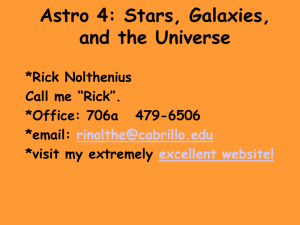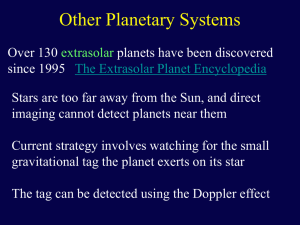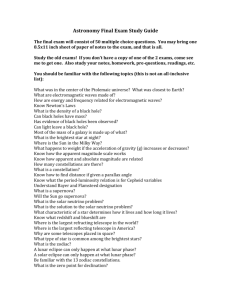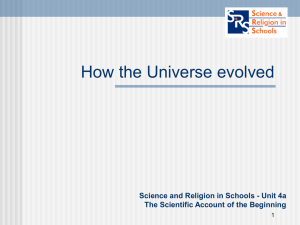Cosmos - teachiuliamanicea
advertisement
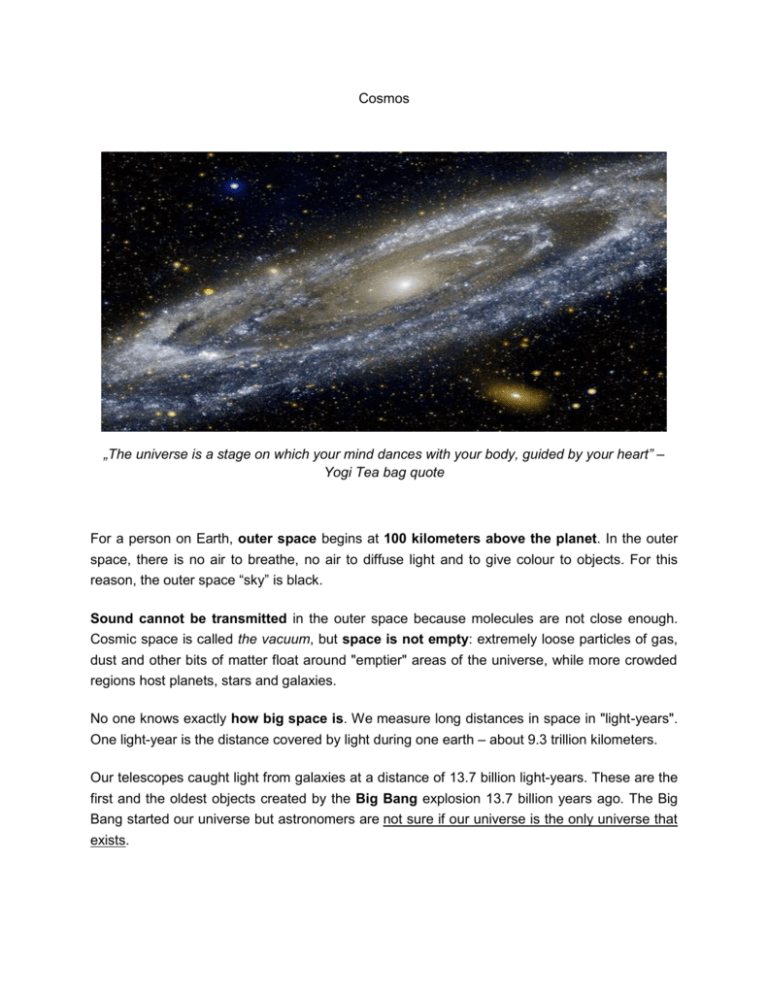
Cosmos „The universe is a stage on which your mind dances with your body, guided by your heart” – Yogi Tea bag quote For a person on Earth, outer space begins at 100 kilometers above the planet. In the outer space, there is no air to breathe, no air to diffuse light and to give colour to objects. For this reason, the outer space “sky” is black. Sound cannot be transmitted in the outer space because molecules are not close enough. Cosmic space is called the vacuum, but space is not empty: extremely loose particles of gas, dust and other bits of matter float around "emptier" areas of the universe, while more crowded regions host planets, stars and galaxies. No one knows exactly how big space is. We measure long distances in space in "light-years". One light-year is the distance covered by light during one earth – about 9.3 trillion kilometers. Our telescopes caught light from galaxies at a distance of 13.7 billion light-years. These are the first and the oldest objects created by the Big Bang explosion 13.7 billion years ago. The Big Bang started our universe but astronomers are not sure if our universe is the only universe that exists. Radiation invisible to human eyes Space may look empty to human eyes but there are invisible forms of radiation emanating through the cosmos. For example - the solar wind (plasma and other particles from the sun) goes past the planets and - causes aurora near the Earth's poles cosmic rays from supernovas outside the solar system go through our neighborhood. The universe is permeated with the cosmic microwave background (CMB). These microwaves are leftovers of the Big Bang that formed our cosmos. The CMB are detected by tvsets and by FM radios. The snow on the screen and the hissing sound on the radio contain about 1% CMB signals picked up by our antennae when we switch stations. The remaining 99% interference comes from other transmissions here on Earth and from other radio emissions from space. Dark matter and dark energy can be detected only through their effects on other objects. Two pieces of evidence for dark matter: - the universe expands and accelerates the bending of the light around a star. Stars, planets, asteroids and comets The universe is full of objects that we can see. The most familiar objects to humans are planets and stars. Stars are immense balls of gas that produce their own radiation. They can range from red supergiants to cooling white dwarfs. The white dwarfs are leftovers of supernovas (star explosions that occur when a big star runs out of gas to burn). These star explosions spread elements throughout the universe (such as iron). Star explosions can generate incredibly dense objects called neutron stars. If a neutron star sends out pulses of radiation, it is called a pulsar star. Planets are celestial bodies that: - orbit the sun, - are large enough to have a round shape, and - have cleared their orbit of debris. The International Astronomical Union (IAU – the governing body on Earth for these decisions) elaborated this definition in 2006; since then, Pluto has no longer been considered a planet, but a "dwarf planet". Asteroids are rocks that are not quite big enough to be dwarf planets. In our own solar system, they are considered to be leftovers from when our neighborhood was forming. They are most concentrated in a “belt” between the planets Mars and Jupiter. In our solar system, comets (sometimes called dirty snowballs) originate from the Oort Cloud (a vast collection of icy bodies). As a comet approaches the sun, the heat melts the ice into gas and dust and the solar wind blows the gas and dust away from the comet. The discovery of Halley's Comet and its periodic return (every 75 years) near the Earth showed that comets were ordinary solar system phenomena. Galaxies and black holes Galaxies are vast collections of stars. Our own galaxy is called the Milky Way, and it has a "barred spiral" shape. There are several types of galaxy shapes: spiral, elliptical, irregular. Often galaxies have supermassive black holes in the center. Black holes are visible through their radiation and through the gravitational interactions with other objects. Smaller black holes can form by the gravitational collapse of a gigantic star. The gravity here is so high that nothing can escape — not even light. It is called a singularity. No one is sure what lies in a black hole, or what happens to a person or object who falls into it. Groups of hundreds or thousands of galaxies can form in clusters, the largest structures in the universe. - http://www.universetoday.com/ http://education.nationalgeographic.com/ http://www.space.com/


